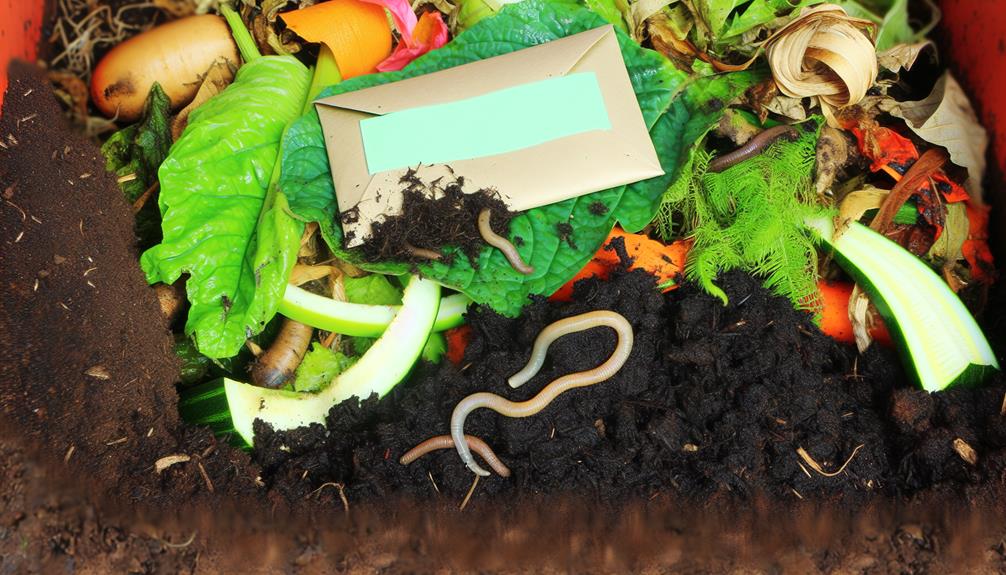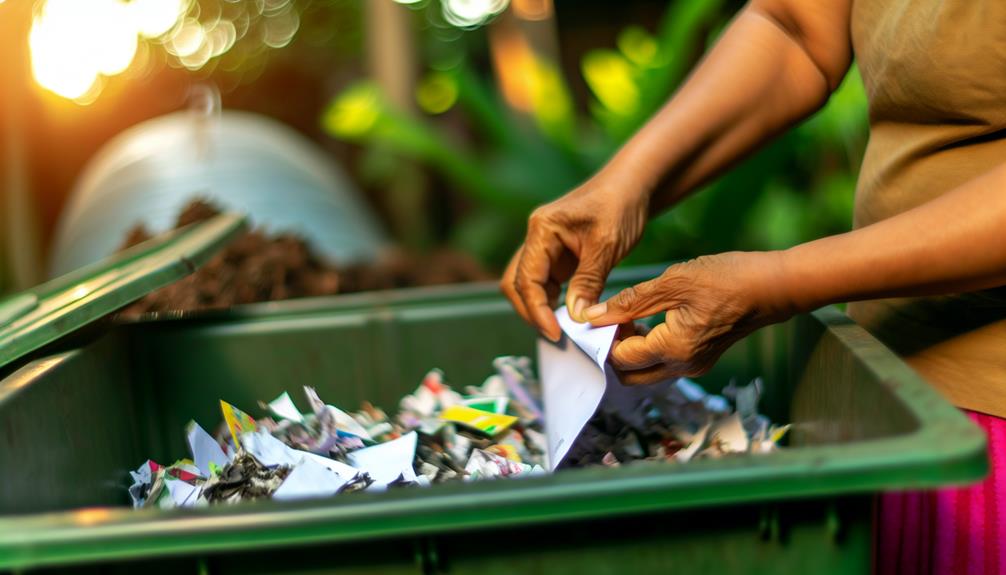

Yes, you can compost some types of mail. Items like plain paper envelopes and non-glossy junk mail are compostable. Before composting, remove non-compostable parts like plastic windows, staples, and adhesive strips. Shred sensitive documents to protect privacy and help decomposition. Avoid mail with glossy finishes, plastic coatings, or toxic inks.
Mixing mail with other compostable materials like fruit peels or grass clippings balances carbon and nitrogen levels, encouraging quicker decomposition. Composting mail reduces waste, enriches the soil, and promotes sustainability. For more detailed practices and tips on successful composting, explore advanced methods and guidelines.
Not all mail is compostable, but some types can be easily broken down in a compost pile. When you’re sorting through your mail, look for envelopes made from plain paper. These can usually go straight into your compost bin.
However, watch out for envelope windows. If the window is made of plastic, you’ll need to remove it before composting the rest of the envelope.
Pay attention to adhesive labels, too. Labels often contain plastics or chemicals that aren’t compost-friendly. Peel off any labels before adding the mail to your compost. If you find that removing the labels is difficult, consider shredding the paper around them to make sure the compost pile stays clean.
Junk mail that’s printed on regular paper without glossy finishes can also be composted. Just make sure it’s free from any synthetic materials.
As you become more familiar with the types of compostable mail, you’ll find it easier to identify what can and can’t be included in your compost bin. By carefully choosing what mail to compost, you’re contributing to a more sustainable environment and connecting with a community of eco-conscious individuals.
Also Read: Can You Compost Celery?
When composting mail, you should avoid materials that can contaminate your compost. Plastic-coated paper, glossy magazines, and colored inks often contain chemicals that can harm your compost and garden.
Stick to plain, untreated paper to guarantee a healthier composting process.
Plastic-coated paper frequently poses a significant problem in composting due to its inability to break down naturally. When you encounter mail with plastic coatings, it’s best to set it aside. These coatings create a barrier that prevents microorganisms from breaking down the paper fibers.
Unlike biodegradable polymers or wax coatings, which can sometimes decompose under the right conditions, plastic-coated paper doesn’t offer the same compostable qualities.
If you’re aiming to maintain an eco-friendly compost pile that integrates well with your community values, avoiding plastic-coated paper is important. This type of paper can contaminate your compost, rendering it less effective and potentially harmful to your garden.
Instead, focus on using paper that’s either uncoated or treated with biodegradable materials. This will help make sure that your compost stays rich and beneficial for your plants.
Glossy magazines, like plastic-coated paper, should also be excluded from your compost pile. These magazines often have a shiny, smooth finish due to the clay and petroleum-based materials used in their production. This glossy coating greatly slows down the decomposition time, making them unsuitable for composting.
When you add glossy magazines to your compost pile, they can hinder the breakdown process of other organic materials. They don’t decompose efficiently and can even introduce harmful chemicals into your compost. This not only affects the quality of your compost but also has a negative environmental impact. By avoiding glossy magazines, you’re ensuring that your compost remains free from potentially toxic substances.
Instead of composting, consider recycling glossy magazines. Many recycling centers accept them, ensuring they’re processed correctly without harming the environment. You can also repurpose them for crafts or donate them to schools and community centers.
Being mindful of what you add to your compost pile helps create a healthier, more sustainable environment. By excluding glossy magazines, you’re taking a small but remarkable step towards better composting practices and a greener planet. Stick to materials that decompose naturally and contribute positively to your compost.
Despite their vibrant appearance, colored inks can introduce harmful chemicals into your compost pile. These inks often contain toxic chemicals that don’t break down easily, posing risks to the health of your soil and plants. When you’re sorting mail for composting, it’s essential to be cautious about the type of ink used.
Here’s a quick guide to help you:
| Type of Ink | Potential Harm | Recommendation |
|---|---|---|
| Water-based | Low toxicity | Safe to compost |
| Soy-based | Low toxicity | Safe to compost |
| Petroleum-based | High toxicity | Avoid composting |
| Acrylic-based | Moderate toxicity | Avoid composting |
| UV-cured | High toxicity | Avoid composting |
Also Read: Can You Compost Basil?
Prior to composting mail, it’s important to separate any non-compostable materials like plastic windows or staples. Start by carefully removing these elements from envelopes. This step guarantees that your compost pile stays free from contaminants.

Next, consider envelope adhesives. Some adhesives can contain synthetic materials that may not break down easily. If you can, peel off any adhesive strips or sections to maintain the purity of your compost.
Don’t forget to protect your personal information. Shred or tear up any mail that contains sensitive details before adding it to the compost pile. This not only helps with decomposition but also safeguards your privacy.
Once you’ve prepped the mail by removing non-compostable parts and protecting your information, you’re ready to add it to your compost bin. Make sure to mix it well with other compostable materials like fruit peels or grass clippings. This will help balance the carbon and nitrogen levels in your compost, promoting quicker decomposition.
Recycling your mail through composting not only reduces waste but also enriches your soil with valuable nutrients. By incorporating mail into your compost pile, you’re directly contributing to environmental sustainability. It’s a simple way to lessen your carbon footprint, as composting paper products helps reduce methane emissions from landfills. Plus, you’re turning what would be waste into a resource that benefits your garden.
When you compost mail, you’re engaging in waste reduction. This process diverts paper from landfills and reduces the need for synthetic fertilizers. The decomposed mail adds organic matter to your compost, improving soil structure, water retention, and nutrient availability. Your plants will thrive in this enriched environment, promoting a healthier garden.
Composting mail also fosters a sense of community among environmentally conscious individuals. By sharing your composting practices, you encourage others to adopt similar habits, creating a ripple effect of sustainability. You’re not just helping your garden; you’re part of a larger movement towards a greener planet.
Also Read: Can You Compost Barbecue Sauce?
While composting mail offers numerous benefits, it does come with its own set of challenges. The most significant issues are contamination risks and varying decomposition rates. Understanding these challenges will help you become a more effective composter.

One of the main concerns is contamination risks. Mail often contains inks, adhesives, and plastic windows that can harm your compost pile. These contaminants not only slow down the decomposition process but can also introduce harmful chemicals into your compost. It’s essential to carefully sort through your mail, removing any non-compostable elements.
Decomposition rates also pose a challenge. Different types of mail decompose at varying speeds, which can disrupt the balance of your compost heap. For instance, glossy paper and envelopes with plastic windows take longer to break down compared to plain paper. This disparity can lead to uneven composting results, requiring more frequent monitoring and mixing.
Here’s a quick overview:
| Challenge | Cause | Effect |
|---|---|---|
| Contamination Risks | Inks, adhesives, plastics | Harmful chemicals in compost |
| Decomposition Rates | Different paper types | Uneven composting |
| Sorting Effort | Manual sorting required | Time-consuming |
| Monitoring | Varying decomposition speeds | Frequent pile maintenance |
Being aware of these challenges can help you maintain a healthy and effective compost pile.
Also Read: Can You Compost Artichoke?
To overcome the challenges of composting mail, follow these practical tips for maintaining a healthy compost pile.
First, stick to composting basics: separate your mail carefully, making sure it’s free from plastic windows, glossy coatings, and any non-compostable elements. Opt for compost bins that offer good aeration and drainage, as these are vital for breaking down organic materials efficiently.
Shred your paper mail before adding it to the compost pile. Smaller pieces decompose faster and integrate better with other compostable materials.
Balance is key – you’ll want to mix your shredded mail (a ‘brown’ material) with ‘green’ materials like kitchen scraps and grass clippings. This balance helps maintain the right carbon-to-nitrogen ratio essential for effective composting.
Turn your compost pile regularly to promote aeration and speed up the decomposition process. A well-aerated compost bin ensures that microorganisms thrive, aiding in breaking down the mail and other organic matter.
Keep your compost moist but not soggy; think of a wrung-out sponge.
When you’re composting mail, paper decomposition typically takes around 2-6 months. Mail biodegradability depends on factors like paper type and compost conditions. Join fellow eco-enthusiasts in reducing waste and nurturing our planet.
You’re probably wondering about composting mail with adhesive labels or stickers. For best results, focus on adhesive breakdown and sticker removal. Join the eco-friendly community by ensuring only biodegradable components go into your compost.
If your compost pile attracts pests, don’t worry! Use natural deterrents like crushed eggshells or coffee grounds, and consider installing compost fencing. You’re part of a community of eco-conscious individuals, and we’ve all been there.
To keep your compost pile healthy, turn it every two weeks. This turning frequency guarantees proper mail aeration and helps break down materials faster. Your efforts create a thriving, eco-friendly community, benefiting everyone involved.
Yes, there are environmental regulations. You should check local recycling programs to guarantee compliance. Be mindful of ink toxicity, as some inks can harm your compost. Joining community composting groups can provide further guidance and support.
Now that you know the basics, you can confidently compost mail. Always separate compostable items from those with plastic or glossy finishes.
Tear larger pieces for quicker decomposition. Remember, composting mail not only reduces waste but also enriches your compost pile.
Stay vigilant about what you add to guarantee a healthy balance. With these tips, you’ll be well on your way to a more sustainable and eco-friendly lifestyle.
Happy composting!
